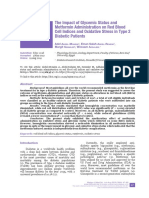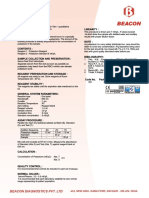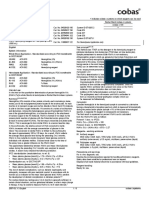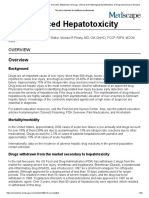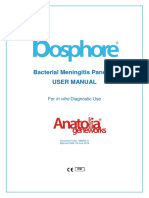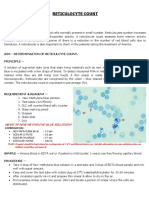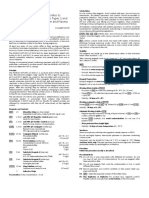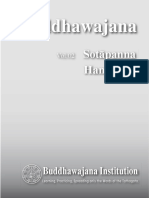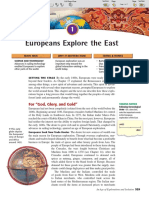(Dsi) Ds-Eia-Anti-Toxo-G 014 19 05 2014
(Dsi) Ds-Eia-Anti-Toxo-G 014 19 05 2014
Uploaded by
abdalazeez20122013Copyright:
Available Formats
(Dsi) Ds-Eia-Anti-Toxo-G 014 19 05 2014
(Dsi) Ds-Eia-Anti-Toxo-G 014 19 05 2014
Uploaded by
abdalazeez20122013Original Description:
Original Title
Copyright
Available Formats
Share this document
Did you find this document useful?
Is this content inappropriate?
Copyright:
Available Formats
(Dsi) Ds-Eia-Anti-Toxo-G 014 19 05 2014
(Dsi) Ds-Eia-Anti-Toxo-G 014 19 05 2014
Uploaded by
abdalazeez20122013Copyright:
Available Formats
DSI S.r.l.
Instructions for use “DS-EIA-ANTI-TOXO-G”
T-151 96
Code: 2.1.GB
0483
For In vitro Diagnostic Use
INSTRUCTIONS FOR USE
“DS-EIA-ANTI-TOXO-G”
ENZYME IMMUNOASSAY FOR THE QUALITATIVE AND QUANTITATIVE
DETECTION OF IgG ANTIBODIES TO TOXOPLASMA GONDII
ATTENTION!
1. Chapter VI has been changed.
Page 1 of 12 Revision 014 2014-05-19
DSI S.r.l. Instructions for use “DS-EIA-ANTI-TOXO-G”
Table of contents
I. INTENDED USE.......................................................................................................................... 3
II. INTRODUCTION........................................................................................................................ 3
III. PRINCIPLE OF THE TEST....................................................................................................... 3
IV. CONTENT OF THE KIT “DS-EIA-ANTI-TOXO-G”.............................................................. 3
V. PRECAUTIONS.......................................................................................................................... 4
VI. HEALTH AND SAFETY INSTRUCTIONS............................................................................. 5
VII. MATERIALS AND EQUIPMENT REQUIRED BUT NOT PROVIDED WITH
THE KIT........................................................................................................................................... 5
VIII. COLLECTION AND HANDLING OF SPECIMENS............................................................ 6
IX. PREPARATION OF THE REAGENTS.................................................................................... 6
X. TEST PROCEDURE................................................................................................................... 7
XI. RESULTS................................................................................................................................... 8
XII. INTERPRETATION OF RESULTS OF THE QUANTITATIVE ASSAY............................. 9
XIII. CONDITIONS OF STORAGE AND TRANSPORTATION................................................. 10
XIV. REFERENCES........................................................................................................................ 10
XV. EXPLANATION OF SYMBOLS…………………………………………………...….…… 11
ANNEX……………………………………………………………………………………….…... 12
Page 2 of 12 Revision 014 2014-05-19
DSI S.r.l. Instructions for use “DS-EIA-ANTI-TOXO-G”
This Package Insert provides information for Professional Use of the kit.
The kit contains sufficient reagents for 96 (one breakable plate) assays including controls; partial
use of the kit is possible.
I. INTENDED USE
The “DS-EIA-ANTI-TOXO-G” kit is intended for the detection of IgG antibodies specific to
Toxoplasma gondii in human serum (plasma).
For In Vitro Diagnostic Use.
II. INTRODUCTION
T. gondii is an obligate intracellular protozoan parasite with a worldwide distribution (1, 2).
Serological data indicate that approximately 30% of the population of most industrialized nations is
chronically infected with the organism (3). When a seronegative woman become infected T. gondii
during pregnancy, the organism is often transmitted across the placenta to the fetus (1, 4). The severity
of infection in the fetus varies with the trimester during which the infection was acquired. Infection
during the trimester may lead to spontaneous abortion, stillbirth or overt disease in the neonate.
Approximately 75% of congenitally infected newborns are symptomatic. However, nearly all children
born with subclinical toxoplasmosis will develop adverse ocular or neurologic sequelae later in
life (4, 7). Approximately 80-85% develops chorioretinitis and some may also experience blindness or
mental retardation.
III. PRINCIPLE OF THE TEST
The “DS-EIA-ANTI-TOXO-G” plates are coated with Toxoplasma gondii specific proteins.
Serum to be tested is diluted and incubated with the precoated plate. In this step Toxoplasma gondii
specific antibodies are bound to the immobilized Toxoplasma gondii specific proteins. Non specific
antibodies are removed by washing. Anti-human IgG conjugated to horseradish peroxidase (HRP)
is added and incubated. In this step the HRP-conjugate is bound to the prebound
antigen-antibody complex. Unbound conjugate is removed by washing. The presence of bound enzyme
indicating the presence in the specimen of specific antibodies is revealed by a color change in
substrate/chromogen (TMB) mixture.
IV. CONTENT OF THE KIT “DS-EIA-ANTI-TOXO-G”
Table 1
LABEL NATURE OF THE REAGENTS PRESENTATION
Polystyrene stripped plate with colorless transparent wells
T. gondii-Ag
coated with mix of recombinant antigens of T. gondii. 1 plate
Coated Strips
Store at 2-8 °C until expiration date.
Concentrate of the monoclonal antibodies against human IgG,
Conjugate produced in mice, conjugated with HRP enzyme. Colorless or
1 vial
(concentrated light yellow transparent or slightly opalescent liquid. Preserving
1.25 ml
11-fold) agent: 0.04% gentamycin sulfate, 0.04% ProClin 300. Store
at 2-8 °C until expiration date in a tightly sealed vial.
Inactivated human serum, containing species specific IgG
antibodies against T. gondii. The serum does not contain HBsAg,
Positive
HIV-1,2 & HCV antibodies. Transparent or slightly opalescent 1 vial
Control,
liquid, red colored. Preserving agent: 0.04% ProClin 300, 1.2 ml
Inactivated
< 0.1% sodium azide. Store at 2-8 °C until expiration date in a
tightly sealed vial.
Inactivated human serum, not containing species specific
antibodies against T. gondii. The serum does not contain
Negative
HBsAg, HIV-1,2 & HCV antibodies. Green transparent or 1 vial
Control,
slightly opalescent liquid. Preserving agent: 0.01% thimerosal, 2.5 ml
Inactivated
< 0.1% sodium azide. Store at 2-8 °C until expiration date
in a tightly sealed vial.
Page 3 of 12 Revision 014 2014-05-19
DSI S.r.l. Instructions for use “DS-EIA-ANTI-TOXO-G”
Inactivated human serum, containing species specific
IgG antibodies against T. gondii with concentration of
(125.0 ± 2.5) IU/ml. The serum does not contain HBsAg,
Calibrator, 1 vial
HIV-1,2 & HCV antibodies. Colorless transparent or slightly
Inactivated 1.5 ml
opalescent liquid. Preserving agent: < 0.1% sodium azide,
0.1% phenol. Store at 2-8 °C until expiration date in a tightly
sealed vial.
Sample buffer that is used to dilute samples before analysis.
Sample Violet-blue transparent liquid with possible sedimentation. 1 vial
diluent Preserving agent: < 0.1% sodium azide. Store at 2-8 °C until 12.5 ml
expiration date in a tightly sealed vial.
Buffer that is used to dilute the Conjugate concentrated before
analysis. Yellow or light yellow transparent or slightly
Conjugate 1 vial
opalescent liquid with possible sedimentation. Preserving
diluent 12.5 ml
agent: 0.01% thimerosal, 0.2% phenol. Store at 2-8 °C until
expiration date in a tightly sealed vial.
Washing Transparent or slightly opalescent liquid, colorless, or
Solution pale yellow, sediment may form that dissolves at 35-39 °C 1 vial
(concentrated and shaking. Store at 2-8 °C until expiration date in a tightly 50.0 ml
25-fold) sealed vial.
Citric acid and sodium acetate solution, pH 4.1-4.3,
Substrate containing H2O2. Transparent colorless liquid. Preserving 1 vial
Buffer agent: 0.04% ProClin 300. Store at 2-8 °C until expiration date 25.0 ml
in a tightly sealed vial.
TMB Solution containing Tetramethylbenzidine (TMB). Transparent
1 vial
(concentrated colorless liquid. Store at 2-8 °C until expiration date in a tightly
1.5 ml
11-fold) sealed vial.
Stopping 0.2 M/L sulphuric acid solution. Transparent colorless liquid. 1 vial
Reagent Store at 2-8 °C until expiration date in a tightly sealed vial. 25.0 ml
Additionally the following may be included in the delivery set:
a lid for polystyrene 96-well plates or a protective film for EIA plates;
disposable tips;
a plastic dish for liquid reagents;
a plastic clip or a self-sealing plastic bag.
V. PRECAUTIONS
The reliability of the results depends on correct implementation of the following Good
Laboratory Practices:
The temperature in the lab should be 18-24 °C.
Do not use expired reagents.
Do not mix reagents from different lots within a given test run.
Before use, it is necessary to wait 30 minutes for the reagents to stabilize to room
temperature (18-24 °C).
Carefully reconstitute the reagents avoiding any contamination.
Do not carry out the test in the presence of reactive vapors (acid, alkaline, aldehyde vapors) or
dust that could alter the enzyme activity of the conjugates.
Use glassware thoroughly washed and rinsed with deionized water or preferably, disposable
material.
Do not allow the microplate to dry between the end of the washing operation and the reagent
distribution.
The enzyme reaction is very sensitive to metal ions. Consequently, do not allow any metal
element to come into contact with the various conjugate or substrate solutions.
Page 4 of 12 Revision 014 2014-05-19
DSI S.r.l. Instructions for use “DS-EIA-ANTI-TOXO-G”
Use a new distribution tip for each sample.
Well washing is a critical step in this procedure: respect the recommended number of washing
cycles and make sure that all wells are completely filled and then completely emptied. Incorrect
washing may lead to inaccurate results.
Never use the same container to distribute conjugate and color development solution.
Check the pipettes and other equipment for accuracy and correct operation.
Do not change the assay’s procedure.
Use high quality water.
Avoid exposure of the reagents to excessive heat or sunlight during storage and incubation.
VI. HEALTH AND SAFETY INSTRUCTIONS
All reagents included in the kit are intended for “in vitro diagnostic use”.
Human origin material used in the preparation of the Negative Control, the Positive Control,
the Calibrator have been tested and found negative for HBsAg, antibodies to hepatitis C and
antibodies to human immunodeficiency virus (HIV-1 and HIV-2), antigen p24 HIV-1.
Because no known test method can offer complete assurance that infections agents are absent,
handle reagents and patients samples as if capable of transmitting infections disease.
Do not eat, drink, smoke, or apply cosmetics where immunodiagnostic materials are
being handled.
Do not pipette by mouth.
Any equipment directly in contact with specimens and reagents as well as washing solutions
should be considered as contaminated products and treated as such.
Wear lab coats and disposable gloves when handling reagents and samples and thoroughly
wash your hands after handling them.
Avoid spilling samples or solutions containing samples.
Avoid any contact of the Substrate Buffer, the TMB and the Stopping Reagent with the skin
and mucosa.
Provide adequate ventilation.
Do not forget to neutralize and/or autoclave the washing wastes or reagents or any fluids
containing biological samples before discarding them into the sink. Solid wastes (used plates,
tips, bottles, glassware, etc.) should be disinfected autoclaving for 1 hour at temperature
124-128 °С and pressure 1.5 kgf/cm2 (0.15 MPa). Solid wastes can be disinfected by steeping
into 3% of chloramine B solution (disinfection time is not less than 1 hour) or other disinfecting
agent authorized for production and use. Liquid wastes (washing water) should be disinfected
by dry chloramine B added in concentration 30 g/l (disinfection time is not less than 2 hours)
or by other chlorine-containing matter. Tools and equipment should be wiped 2 times
by 70% ethanol before and after work.
VII. MATERIALS AND EQUIPMENT REQUIRED BUT NOT PROVIDED WITH THE KIT:
Distilled or deionized water.
Pipettes, single-channel and multi-channel, adjustable or preset, to measure and dispense
10 µl, 50 µl, 90 µl, 100 µl.
Disposable pipette tips.
Microplate incubator at (37.0 ± 1.0) °C.
Automatic microplate washer.
Microplate reader equipped with 450 nm or with 450 nm and 620-680 nm filters.
Disposable gloves.
Page 5 of 12 Revision 014 2014-05-19
DSI S.r.l. Instructions for use “DS-EIA-ANTI-TOXO-G”
VIII. COLLECTION AND HANDLING OF SPECIMENS
Collection of blood samples should be implemented according to the current practices. Serum,
plasma may be used. Separate serum or plasma from blood cells as soon as possible to avoid any
hemolysis. Extensive hemolysis may affect test performance. Specimens with observable particulate
matter should be clarified by centrifugation prior to testing. Suspended fibrin particles or aggregates
may yield falsely positive results. Do not heat the samples.
Samples can be stored at 2-8 °C not more than for 72 hours; they may be deep-frozen at -20 °C.
Plasma must be quickly thawed by warming for a few minutes at 40 °C (to avoid fibrin precipitation).
Avoid repeated freeze/thaw cycles. Samples that have been frozen and defrosted more than 1 time
cannot be used. Samples with expressed hemolysis, hyperlipidemia must not be analyzed.
IX. PREPARATION OF THE REAGENTS
1. Ready to use reagents:
Positive Сontrol;
Negative Сontrol;
Sample diluent;
Conjugate diluent;
Calibrator;
Stopping Reagent.
2. Reagents to prepare:
Working Washing Solution. Thoroughly shake Washing Solution concentrate. To make
Working Washing Solution take required amount of concentrate and mix with distilled or
deionized water (1:25 ratio) in a separate vial (See Table 2). Thoroughly mix the solution. The
prepared Working Washing Solution is stable at least for 14 days at 18-24 °C or for 28 days
at 2-8 °C when used in GLP condition.
Working Solution of Conjugate must be prepared before usage. Thoroughly shake conjugate
concentrate. To make Working Solution of Conjugate, take required amount of concentrate and
mix with Conjugate diluent (1:11 ratio) in a separate vial (See Table 2). Thoroughly mix.
Do not apply intensive mixing. Working Solution of Conjugate may be stored for not more
than 12 hours at room (18-24 °C) temperature in a dark place.
Substrate Mixture must be prepared before usage. Take required amount of TMB
(concentrated 11-fold) to a separate vial and add required amount of Substrate Buffer
(1:11 ratio) (See Table 2). Mix thoroughly. Substrate Mixture may be stored for not more than
10 hours at room (18-24 °C) temperature in a dark place.
Substrate Mixture must be colorless!
3. Storage of unused reagents:
After opening the bottles the unused components of the kit: Conjugate (concentrated 11-fold),
Negative Control, Positive Control, Calibrator, Sample diluent, Conjugate diluent, Washing Solution
(concentrated 25-fold), Substrate Buffer, Stopping Reagent, TMB (concentrated 11-fold) can be stored
in tightly sealed bottles until the kit expiration date at 2-8 °C.
Page 6 of 12 Revision 014 2014-05-19
DSI S.r.l. Instructions for use “DS-EIA-ANTI-TOXO-G”
X. TEST PROCEDURE
The required volumes of reagents for the certain number of strips or a plate are represented
in Table 2.
Table 2
Consumption of reagents for the manual test-procedure
Working Washing Working Solution of
Substrate Mixture
The Solution Conjugate
number Washing Solution Distilled or Conjugate TMB
of used Conjugate Substrate
(concentrated deionized (concentrated (concentrated
strips diluent Buffer
25-fold) water 11-fold) 11-fold)
(ml) (ml)
(ml) (ml) (ml) (ml)
1 4.0 96.0 0.1 1.0 0.1 1.0
2 8.0 192.0 0.2 2.0 0.2 2.0
3 12.0 288.0 0.3 3.0 0.3 3.0
4 16.0 384.0 0.4 4.0 0.4 4.0
5 20.0 480.0 0.5 5.0 0.5 5.0
6 24.0 576.0 0.6 6.0 0.6 6.0
7 28.0 672.0 0.7 7.0 0.7 7.0
8 32.0 768.0 0.8 8.0 0.8 8.0
9 36.0 864.0 0.9 9.0 0.9 9.0
10 40.0 960.0 1.0 10.0 1.0 10.0
11 44.0 1056.0 1.1 11.0 1.1 11.0
12 50.0 1200.0 1.2 12.0 1.2 12.0
Note: Before use, allow reagents to reach room temperature (18-24 °C) for 30 min.
1. Bring all components and clinical specimens to be tested to room temperature. Mix well
the Positive Control, Negative Control and the clinical specimens before use.
2. Determine the total number of specimens to be tested. In addition to the specimens, the
following must be included in each test: two wells of Negative Control, one well of Positive Control
and two wells of Calibrator.
3. Open package and take out frame and required number of strips (according to the number
of specimens to be tested). Leave unused strips in a package and do not remove silica gel drier, and
then reseal the package with a plastic clip or place the package in a self-sealing plastic bag, seal.
Resealed coated plate may be stored at 2-8 °C for 6 months.
4. Add 100 µl of the Calibrator and 100 µl of the Negative Control in duplicates.
Add 100 µl of Positive Control.
5. Pipette 90 µl of Sample diluent and 10 µl of the tested sera samples to the rest of the wells
(serum dilution ratio is 1:10). Carefully mix fluid in wells by gentle pipetting. Violet-blue color should
change to blue-green. If you don’t observe change of the color then test results may be false, or there is
no serum added to the well.
6. Cover the strips with a plate lid or a protective film and incubate for 30 min at (37.0 ± 1.0) °C.
7. Remove fluid from wells by multichannel pipette or washer, discard fluid according to
rules of work with potentially infectious material. Wash the plate with Working Washing Solution
4 times: сarefully fill all wells with at least 380 µl of Working Washing Solution with multichannel
pipette or automatic washer, wait for 40 seconds and remove Working Washing Solution from the
wells. Do not leave any fluid in the wells.
8. Pipette 100 µl of Working Solution of Conjugate into wells.
9. Cover the plate with a lid or a protective film and incubate for 30 min at (37.0 ± 1.0) °C.
10. Remove fluid from wells by multichannel pipette or automatic microplate washer. Wash
the plate with Working Washing Solution 4 times, (see procedure 7).
Page 7 of 12 Revision 014 2014-05-19
DSI S.r.l. Instructions for use “DS-EIA-ANTI-TOXO-G”
11. Add 100 µl of Substrate Mixture into wells.
12. The plate incubates at 18-24 °C for a 20 min in a dark place.
13. Add 150 µl of Stopping Reagent into each well and read the optical density. Read
the optical density at 450/620-680 nm using a plate reader. Reading the absorbance at 450 nm only
is possible.
Scheme of the assay is represented in Annex.
XI. RESULTS
Test Validation
For the test to be valid the following criteria must be met. If these criteria are not met the test
should be considered invalid and should be repeated.
1. Positive Control: The absorbance value should not be less than 0.600 at 450/620 nm.
2. Negative Control: The absorbance value should not be more than 0.200 at 450/620 nm.
3. Calibrator: The absorbance value should not be less than 0.700 at 450/620 nm.
1. Qualitative results
The presence or absence of antibodies against T. gondii is determined by the ratio of the OD of
each sample to the calculated cut-off value.
Calculate Cut-Off value as:
Сut-Off = average OD value of Calibrator / 5 (1)
where 5 – is a coefficient defined by manufacturer during statistical processing for each lot.
Interpretation of Results
Sample is positive, if the OD value is ≥ 1.2×Cut-Off.
Sample is negative, if the OD value is ≤ 0.8×Cut-Off.
Sample is equivocal if the OD value exceeds 0.8×Cut-Off, but less than 1.2×Cut-Off.
2. Quantitative results
The concentration of ANTI-TOXO-IgG calculate only for positive samples.
If the sample OD doesn’t exceed 2.000, calculate anti-toxo IgG concentration as:
Concentration [IU/ml] = OD sample x 125 / average OD value of Calibrator (2),
where 125 is the concentration of anti-Toxo IgG antibody of the calibrator (IU/ml).
If the OD exceeds 2.000, the sample should be measured at 405/620-680 nm.
If the OD measured at 405/620-680 nm doesn’t exceed 1.200, calculate anti-Toxo-IgG
concentration as:
Concentration [IU/ml] = OD sample x 125 x 3.2 / average OD value of Calibrator, (3)
where OD sample is the value of optical density with 405/620-680 nm of the investigated sera;
average OD value of Calibrator is average optical density of Calibrator
at 450 and 620-680 nm;
125 is Toxo IgG antibody concentration of the calibrator (IU/ml);
3.2 is the conversion coefficient.
If the OD measured at 405/620-680 nm exceeds 1.200, or if the filter 405 is not available, the
analysis should be repeated with the sample diluted with the Working Washing Solution 1:4.
Calculating the concentration of anti-Toxo-IgG take into account the dilution factor.
Page 8 of 12 Revision 014 2014-05-19
DSI S.r.l. Instructions for use “DS-EIA-ANTI-TOXO-G”
XII. INTERPRETATION OF RESULTS OF THE QUANTITATIVE ASSAY
If the level of anti-Toxo-G is higher than 30 IU/ml, the result is considered as positive. In this
case it is important to determine the period of infection (to exclude primary toxoplasmosis).
For that it is recommended to test sera for presence of low avidity antibodies. Primary
toxoplasmosis is diagnosed in case of detection low avidity anti-Toxo-G.
In case of absence of low avidity anti-Toxo-G it is recommended to test sera for presence of
anti-Toxo-M, anti-Toxo-A and trace anti-Toxo-G dynamics in pair sera, taken with the interval
of 2-3 weeks.
In case of absence anti-Toxo-M and anti-Toxo-A pregnant women are referred to the “calm”
group (having immunity to toxoplasmosis) and further without clinical indications do not require
examination for toxoplasmosis. But it should be taken into consideration that according to the data of
WHO the concentration level of anti-Toxo-G – 60 IU/ml is protective.
In case of anti-Toxo-M and anti-Toxo-A presence and at increase of anti-Toxo-G concentration
for 2 times and more the acute toxoplasmosis is diagnosed.
At anti-Toxo-G concentration from 20 to 30 IU/ml the result is considered as indefinite.
The indefinite result may testify the start of development of immune response at the acute stage
of the disease. So it is recommended to test sera with indefinite results for avidity of anti-Toxo-G and
for presence of anti-Toxo-M and anti-Toxo-A.
If anti-Toxo-G concentration in the tested sample is 20 IU/ml and less the result is considered
as negative (absence of immunity).
In case of negative and indefinite results pregnant women are referred to the risk group (having
no immunity for toxoplasmosis).
Example calculation
OD at 450/620 nm OD at 405/620 nm
Sample № 1 1.865 0.583
Sample № 2 > 2.0 1.006
Sample № 3 > 2.0 1.246
Sample № 2 diluted 1:4 0.852 -
Sample № 3 diluted 1:4 1.164 -
Calibrator 0.850 -
These results are brought only as an example, they cannot be considered as a working option.
Sample number 1 – is calculated using formula (2):
Concentration [IU/ml] = 1.865 x 125 / 0.850 = 274 IU/ml
OD value of sample № 2 measured at 450/620-680 exceeds 2.000. The concentration can be
calculated using the OD 405 = 1.006 and the formula (3):
Concentration [IU/ml] = 1.006 x 125 x 3.2 / 0.850 = 500 IU/ml
The concentration also can be calculated using the OD 450 of diluted sample 1:4 = 0.852 and
the formula (2):
Concentration in diluted sample (1:4) [IU/ml] =0.852 x 125 / 0.850 = 125 IU/ml,
it corresponds to the concentration in the whole sample:
Concentration [IU/ml] = 125 x 4 = 500 IU/ml
OD value of sample № 3 measured at 405/620-680 exceeds 1.200, it means, that the
concentration can be calculated using OD of diluted sample.
Page 9 of 12 Revision 014 2014-05-19
DSI S.r.l. Instructions for use “DS-EIA-ANTI-TOXO-G”
It can be calculated using the OD 450 of diluted sample 1:4 = 1.164 and the formula (2):
Concentration in diluted sample (1:4) [IU/ml] = 1.164 x 125 / 0.850 = 171 ME/ml,
it corresponds to the concentration in the whole sample:
Concentration [IU/ml] = 171 x 4 = 684 IU/ml
OD value of sample № 3 measured at 405/620-680 exceeds 1.200, it means, that the
concentration can be calculated using OD of diluted sample.
XIII. CONDITIONS OF STORAGE AND TRANSPORTATION
Expiry date is indicated on the packaging. Keep in dark dry place at 2-8 °C.
Transportation may be done by all kinds of covered transport at temperature 9-20 °C not more
than during ten (10) days. Freezing is prohibited.
DSI S.r.l.
Saronno (VA), Via A.Volonterio, 36а, 21047, Italy
Tel:+39 02 967 09111, Fax: +39 02 962 0185
E-mail: info@dsitaly.com, www.dsitaly.com
XIV. REFERENCES
1. Krick J.A. and Remington J.S.: Toxoplasmosis in the adult: An overview.
New Eng. J. Med. 298:550-553, 1978.
2. Anderson S.E. and Remington J.S.: The diagnosis of Toxoplasmosis. So. Med. J.
68:1433-1443, 1975.
3. Feldman H.A.: Toxoplasmosis: An overview. Bull. N.Y. Acad. Med. 50:110-127, 1974.
4. Wilson C.B., Remington J.S., Stagno S. and Retnolds D.W.: Development of
adverse sequelae in children born with subclinical congenital Toxoplasma infection.
Pediatrics 66:767-774, 1980.
5. Hugties H.P.A.: Toxoplasmosis: The need for improved diagnositc techniques and accurate
risk assessment. Contem. Topics Micro. Immunol. 120:105-139, 1985.
6. Chernesky M.A., Ray C.G. and Smith T.F.: Laboratory diagnosis of viral infections.
Cumitech 15 American Society for Microbiology, Washington, D.C., 1982.
7. Berrebi A.; Kobuch W.E.; Bessieres M.H.; Bloom M.C.; Rolland M.; Sarramon M.F.;
Roques C.; Fournie A.: Termination of pregnancy for maternal toxoplasmasis.
344 (8914) p36-9 Lancet (England), July 2 1994.
Page 10 of 12 Revision 014 2014-05-19
DSI S.r.l. Instructions for use “DS-EIA-ANTI-TOXO-G”
XV. EXPLANATION OF SYMBOLS
CE marking (European directive 98/79/CE on in vitro diagnostic medical
0483 devices)
For in vitro diagnostic use
Manufacturer
Catalog number
Sufficient for
Batch code
Storage temperature limitation
Expiry date ССYY-MM-DD
Consult Instruction for use
Contains irritant agent
Code: X.X.XX Identification code
Page 11 of 12 Revision 014 2014-05-19
DSI S.r.l. Instructions for use “DS-EIA-ANTI-TOXO-G”
Page 12 of 12
Annex
Scheme of the assay
1 Add 100 µl of Positive Control, Negative Control, Calibrator
2 Add 90 µl of Sample diluent
3 Add 10 µl of the tested sera samples
4 Incubate 30 min, (37.0 ± 1.0) °С, microplate incubator
5 Wash the plate Working Washing Solution, not less than 380 µl, 4 times
Revision 014
6 Add 100 µl of Working Solution of Conjugate
7 Incubate 30 min, (37.0 ± 1.0) °С, microplate incubator
8 Wash the plate Working Washing Solution, not less than 380 µl, 4 times
9 Add 100 µl of Substrate Mixture
10 Incubate 20 min, 18-24 °С in a dark place
11 Add 150 µl of Stopping Reagent
2014-05-19
067 (2.1.GB)
12 Read the optical density 450 nm/620-680 nm or 450 nm
12
You might also like
- Man Repair ManDocument458 pagesMan Repair ManRoberto Santamaria100% (2)
- Innovance Pfa 200 Im 10 enDocument118 pagesInnovance Pfa 200 Im 10 enTrường Bửu TrầnNo ratings yet
- Dens1ag - Ce Dengue Virus NS1 Ag InsertoDocument16 pagesDens1ag - Ce Dengue Virus NS1 Ag Insertovirologia virologiaNo ratings yet
- Russian Beginners - 2019Document123 pagesRussian Beginners - 2019Roman Kim100% (8)
- BDF 86V340Document23 pagesBDF 86V340MAC SUCESORESNo ratings yet
- CWS 315 2I en StudentManual 4 5 Days v02Document600 pagesCWS 315 2I en StudentManual 4 5 Days v02Onurcan YahyaoğluNo ratings yet
- RPR Test KitDocument2 pagesRPR Test KitAlex LiganNo ratings yet
- CGL-breaker 11 KVDocument27 pagesCGL-breaker 11 KVSuraj DahalNo ratings yet
- Package Insert - 048437-01 - en - 422243Document22 pagesPackage Insert - 048437-01 - en - 422243HadiNo ratings yet
- Anti-HAV IgMDocument3 pagesAnti-HAV IgMHassan GillNo ratings yet
- 8725-300 Psa Xs Accubind Elisa Rev 0Document2 pages8725-300 Psa Xs Accubind Elisa Rev 0dr madhusudhan reddyNo ratings yet
- T UptakeDocument3 pagesT UptakeModestus100% (1)
- Ficha Tecnica Dengue Duo SDDocument2 pagesFicha Tecnica Dengue Duo SDDanitxa Leyva100% (1)
- 2325-300 Free PSA AccuBind ELISA Rev 5Document2 pages2325-300 Free PSA AccuBind ELISA Rev 5Emma MNo ratings yet
- Metformina y Estrés Oxidativo en Pacientes DiabéticosDocument14 pagesMetformina y Estrés Oxidativo en Pacientes DiabéticosJesus D. Hernandez GuitianNo ratings yet
- R - Bio-Rad Geenius HIV 1 2 Supplemental Test SSE FinalDocument29 pagesR - Bio-Rad Geenius HIV 1 2 Supplemental Test SSE FinalromerilloNo ratings yet
- Insert - Elecsys Anti-HAV IgM.07026773500.V5.EnDocument4 pagesInsert - Elecsys Anti-HAV IgM.07026773500.V5.EnVegha NedyaNo ratings yet
- Multifibren UDocument6 pagesMultifibren UMari Fere100% (1)
- Liaisonr XL Brochure m0870004248g LRDocument16 pagesLiaisonr XL Brochure m0870004248g LRNganMinh TVNo ratings yet
- BC Tiempo de Trombina Inserto OWNAG11E05Document6 pagesBC Tiempo de Trombina Inserto OWNAG11E05Isa Mar BCNo ratings yet
- Creatinina Jaffe Crco 0600Document4 pagesCreatinina Jaffe Crco 0600Ervin RodriguezNo ratings yet
- PotassiumDocument1 pagePotassiumpsychejaneNo ratings yet
- Proteina C ReactivaDocument2 pagesProteina C ReactivaMaria BlassNo ratings yet
- A1C-2 Whole Blood enDocument6 pagesA1C-2 Whole Blood enSyahdie FahledieNo ratings yet
- Generic Name: 5 - Nucleotidase Kit Abbreviated Name: 5 - NT Order Information Cat. No. Package SizeDocument30 pagesGeneric Name: 5 - Nucleotidase Kit Abbreviated Name: 5 - NT Order Information Cat. No. Package SizeSharom Zelene Cordova RomanNo ratings yet
- Bilirubin Kit PDFDocument2 pagesBilirubin Kit PDFArasNo ratings yet
- Free T3 - IMMULITE 2000 Systems - Rev 24 DXDCM 09017fe9802975f7-1538193198932Document36 pagesFree T3 - IMMULITE 2000 Systems - Rev 24 DXDCM 09017fe9802975f7-1538193198932Jorge Stban PerezNo ratings yet
- Insert - Elecsys Vitamin D Total III.09038078501.V2.enDocument6 pagesInsert - Elecsys Vitamin D Total III.09038078501.V2.ensreerenjNo ratings yet
- Pointe Hemoglobin A1c InsertDocument2 pagesPointe Hemoglobin A1c InsertMario TogniniNo ratings yet
- Manual Helios 1 (Recomendado)Document108 pagesManual Helios 1 (Recomendado)Jose Luis Albornoz HermosillaNo ratings yet
- 2020-03 Fluorecare BrochureDocument6 pages2020-03 Fluorecare BrochureZahid RasoolNo ratings yet
- Drug-Induced Hepatotoxicity - Overview, Metabolism of Drugs, Clinical and Pathological Manifestations of Drug-Induced Liver DiseaseDocument20 pagesDrug-Induced Hepatotoxicity - Overview, Metabolism of Drugs, Clinical and Pathological Manifestations of Drug-Induced Liver Diseaseal ghiffari muhammad rayhan100% (1)
- Electrophoresis: 200 Tests R1 R2 R3 R4Document2 pagesElectrophoresis: 200 Tests R1 R2 R3 R4Wolaé Mathurin Edmond AmegandjinNo ratings yet
- ElecDocument13 pagesElecFaye Almira Zarraga MagpantayNo ratings yet
- Multistix Reagent StripDocument3 pagesMultistix Reagent StripFrancis TorresNo ratings yet
- 20 - Blood Conservation and Transfusion MedicineDocument30 pages20 - Blood Conservation and Transfusion MedicineTiêgo PiresNo ratings yet
- Microscan Gram Negative Procedural Manual, Labpro V4.42 Pu-07 PanelsDocument79 pagesMicroscan Gram Negative Procedural Manual, Labpro V4.42 Pu-07 PanelsPedro Antonio VeraNo ratings yet
- Anti CCP ElisaDocument12 pagesAnti CCP ElisavemalNo ratings yet
- ALT Insert ReagentDocument8 pagesALT Insert ReagentcydolusNo ratings yet
- #694 Lot.45980 EinsertDocument2 pages#694 Lot.45980 Einsertjnyng222No ratings yet
- Bacterial Meningitis - v1f - Eng PDFDocument10 pagesBacterial Meningitis - v1f - Eng PDFmoutasim mohammadNo ratings yet
- Finecare Fs 114Document2 pagesFinecare Fs 114Toto Folly100% (1)
- Generic Name: Unsaturated Iron Binding Capacity Kit (Colorimetric Method) Abbreviated Name: UIBC Order Information Cat. No. Package SizeDocument35 pagesGeneric Name: Unsaturated Iron Binding Capacity Kit (Colorimetric Method) Abbreviated Name: UIBC Order Information Cat. No. Package Sizetech yuva cscNo ratings yet
- a.CCP AlinityDocument7 pagesa.CCP AlinityLoloNo ratings yet
- Chapter FiveDocument155 pagesChapter Fivetadele10No ratings yet
- Caldo UreaDocument4 pagesCaldo UreaDiego AriasNo ratings yet
- INS CR EN CRP Rev.22 - 181109Document3 pagesINS CR EN CRP Rev.22 - 181109Ahmed Ben NjahNo ratings yet
- Creatinine (Alkaline Picrate) PDFDocument1 pageCreatinine (Alkaline Picrate) PDFatul pandey100% (1)
- Infinosis™ 2020 Salessheet 2021 - V180221Document6 pagesInfinosis™ 2020 Salessheet 2021 - V180221sazzadsazib100% (1)
- Bilirubin Calibrator PDFDocument2 pagesBilirubin Calibrator PDFInsan KamilNo ratings yet
- 25-OH Vitamin D: ++++ Change of ++++ Please Read Marked Text Carefully! ++++Document2 pages25-OH Vitamin D: ++++ Change of ++++ Please Read Marked Text Carefully! ++++MaherNo ratings yet
- RETICULOCYTE COUNT by PrakashDocument2 pagesRETICULOCYTE COUNT by PrakashThalapathy PrakashNo ratings yet
- Hemostat Thromboplastin-SI: Determination of Prothrombin Time (PT)Document2 pagesHemostat Thromboplastin-SI: Determination of Prothrombin Time (PT)Lemi MaluluNo ratings yet
- E Anti-TPO en 3Document3 pagesE Anti-TPO en 3Hassan Gill100% (1)
- Nihon Kohden Mek 6318K, Mek 8222K, Mek 7222K, Mek 8118K, MEK 6108 ReagentsDocument1 pageNihon Kohden Mek 6318K, Mek 8222K, Mek 7222K, Mek 8118K, MEK 6108 Reagentsamor kermayaNo ratings yet
- Chemical Method Sterilization Disinfection Powerpoint PresentationDocument33 pagesChemical Method Sterilization Disinfection Powerpoint PresentationVohn Archie EdjanNo ratings yet
- Capi 3 Hemoglobin (E) Using The Capillarys 3 Tera Instrument FamilyDocument28 pagesCapi 3 Hemoglobin (E) Using The Capillarys 3 Tera Instrument Family0fadiiii19900No ratings yet
- Staphylococcus and MicrococcusDocument4 pagesStaphylococcus and MicrococcusAmador GielasNo ratings yet
- Mic Bro004 Urine Culture 28-06-17 en Urine CultureDocument2 pagesMic Bro004 Urine Culture 28-06-17 en Urine Culturebilal gayretliNo ratings yet
- D-Dimer (18-23)Document34 pagesD-Dimer (18-23)Sharom Zelene Cordova RomanNo ratings yet
- Rapid TSH Immulite - 230524111657469Document31 pagesRapid TSH Immulite - 230524111657469laboratorio almarNo ratings yet
- Aplicación Amilasa 120 ElitDocument1 pageAplicación Amilasa 120 ElitFlorelia VazquezNo ratings yet
- anti-HIV 12Document2 pagesanti-HIV 12MaherNo ratings yet
- Hiv Blot 2.2: Instructions For UseDocument10 pagesHiv Blot 2.2: Instructions For Useayuningtyas wahyuNo ratings yet
- CTK Biotech-USA - Rapid Test - TradeDocument1 pageCTK Biotech-USA - Rapid Test - Tradeabdalazeez20122013No ratings yet
- Problems:: Device: Hemoflow 400 Basic S/N: HF 09027Document1 pageProblems:: Device: Hemoflow 400 Basic S/N: HF 09027abdalazeez20122013No ratings yet
- Catalogue (Antigens and Conjugates)Document18 pagesCatalogue (Antigens and Conjugates)abdalazeez20122013No ratings yet
- Catalogue (ELISA, QCP, Bacteriology) AACC 2012Document8 pagesCatalogue (ELISA, QCP, Bacteriology) AACC 2012abdalazeez20122013No ratings yet
- Ets 15Document2 pagesEts 15abdalazeez20122013No ratings yet
- Centron CM 735 KatalogDocument3 pagesCentron CM 735 Katalogabdalazeez20122013No ratings yet
- LV Series: Ultra-Small Inert Solenoid ValveDocument1 pageLV Series: Ultra-Small Inert Solenoid Valveabdalazeez20122013No ratings yet
- Technical Bulletin: Bradford ReagentDocument6 pagesTechnical Bulletin: Bradford ReagentRituparna KalitaNo ratings yet
- Fleta 40P: Operation ManualDocument22 pagesFleta 40P: Operation Manualabdalazeez20122013No ratings yet
- Ar SA 201506031242491 User Manual - FileengUSADocument12 pagesAr SA 201506031242491 User Manual - FileengUSAabdalazeez20122013No ratings yet
- IFU Abia HCV AbDocument12 pagesIFU Abia HCV Ababdalazeez20122013100% (1)
- IFU Abia HCV AbDocument12 pagesIFU Abia HCV Ababdalazeez20122013100% (1)
- Ania DiagnosticDocument12 pagesAnia Diagnosticabdalazeez20122013No ratings yet
- Fully Automated Random Access Clinical Chemistry Analyzer: Unique FeaturesDocument2 pagesFully Automated Random Access Clinical Chemistry Analyzer: Unique Featuresabdalazeez20122013No ratings yet
- Wage Statement: XXX - XXDocument1 pageWage Statement: XXX - XXabdalazeez20122013No ratings yet
- S. Fedorciucova - V. Calmas - M. DamaschinDocument13 pagesS. Fedorciucova - V. Calmas - M. DamaschinAnna BalanNo ratings yet
- Writing Pro Target 9 Study PackDocument20 pagesWriting Pro Target 9 Study Packvik1987100% (1)
- CGP Year 1 Maths WorkoutDocument3 pagesCGP Year 1 Maths WorkoutpalomamorenorocamoraNo ratings yet
- Plan de Lunga Durata La Limba Engleza Pentru Clasa A 5-ADocument24 pagesPlan de Lunga Durata La Limba Engleza Pentru Clasa A 5-AAlexandru Covtun33% (3)
- 0580 w15 QP 42Document16 pages0580 w15 QP 42Shahrizan Noor100% (1)
- GLSEN 2017 National School Climate SurveyDocument193 pagesGLSEN 2017 National School Climate Surveycorey_c_mitchell100% (1)
- Angola NutritionDocument66 pagesAngola NutritioneraumavezNo ratings yet
- Guest Speaker SpeechDocument2 pagesGuest Speaker SpeechLovely Bueno Don-EsplanaNo ratings yet
- Language Acquisition in Diverse Linguistic, Social, and Cognitive Contexts A Paper Review and Synthesis of Multifaceted TheoriesDocument4 pagesLanguage Acquisition in Diverse Linguistic, Social, and Cognitive Contexts A Paper Review and Synthesis of Multifaceted TheoriesJournal of Interdisciplinary PerspectivesNo ratings yet
- ZoomLion Qy50V532Document8 pagesZoomLion Qy50V532Otto Heinrich Wehmann100% (2)
- Modes of Clutch FailureDocument40 pagesModes of Clutch Failurebroshan100% (1)
- Essential Elements of Writing ProcessDocument6 pagesEssential Elements of Writing ProcesssabaahatNo ratings yet
- Approaches To Curriculum Design 2Document47 pagesApproaches To Curriculum Design 2PreciousMaviSalemCarcosiaNo ratings yet
- Sotapanna Handbook English Version-2Document236 pagesSotapanna Handbook English Version-2Ansell JayaNo ratings yet
- Synopsys ASIC Design FlowDocument18 pagesSynopsys ASIC Design FlowNishant Singh100% (1)
- GC-MS Analysis of Bioactive Compounds From The Whole Plant Ethanolic Extract of Evolvulus Alsinoides (L.) LDocument6 pagesGC-MS Analysis of Bioactive Compounds From The Whole Plant Ethanolic Extract of Evolvulus Alsinoides (L.) LGem29No ratings yet
- CSC303 - Digital ForensicsDocument35 pagesCSC303 - Digital ForensicsbrijendersinghkhalsaNo ratings yet
- Solomon HaileyesusDocument42 pagesSolomon HaileyesusAlembrhanHadsh100% (3)
- Gow Gates Nerve BlockDocument4 pagesGow Gates Nerve BlockHudh HudNo ratings yet
- driving_theory_practical_test_uk_highway_code_ebook_pdf_2025Document32 pagesdriving_theory_practical_test_uk_highway_code_ebook_pdf_2025Noeline RazanatsimbaNo ratings yet
- Synthesis: Modern ProductionDocument2 pagesSynthesis: Modern ProductionVinod NairNo ratings yet
- Cause - Effect - Grammar QuizzesDocument3 pagesCause - Effect - Grammar QuizzesDestianNo ratings yet
- Innovation in Precision Fermentation For Food IngredientsDocument22 pagesInnovation in Precision Fermentation For Food IngredientsBabuskin SrinivasanNo ratings yet
- 07.europeans Explore The East PDFDocument7 pages07.europeans Explore The East PDFJuanmaseta100% (1)
- NT 20/1 Me Classic NT 30/1 Me Classic NT 38/1 Me Classic: English 5 中文 11 Indonesia 17 ᅋᄒᄕᄏ 23Document32 pagesNT 20/1 Me Classic NT 30/1 Me Classic NT 38/1 Me Classic: English 5 中文 11 Indonesia 17 ᅋᄒᄕᄏ 23Cristian GamarraNo ratings yet
- Ceramic Dec15Document146 pagesCeramic Dec15kidcat0% (2)














